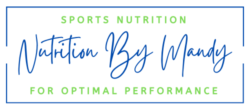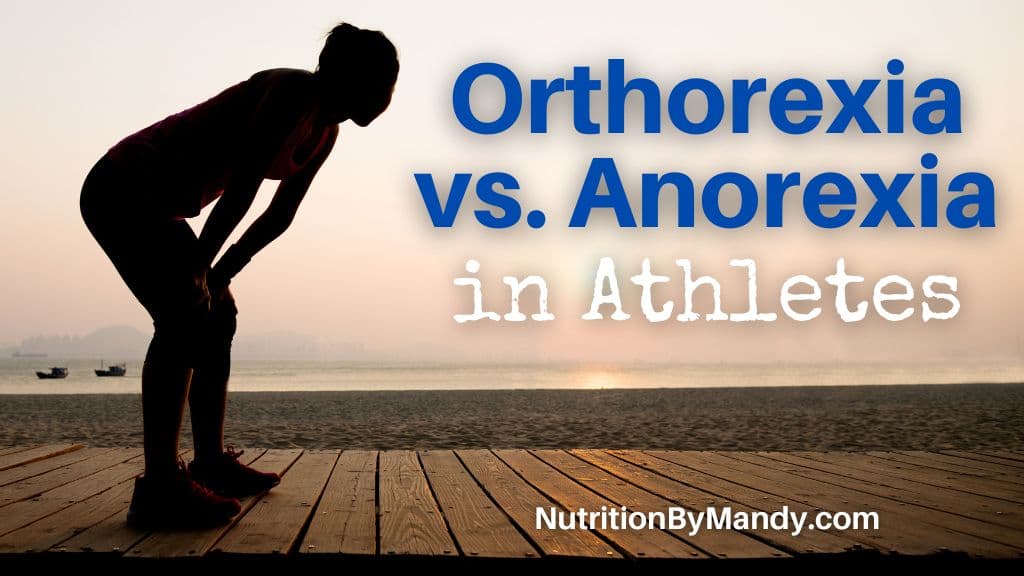Orthorexia vs. Anorexia in Athletes
Disordered eating patterns can have a negative impact on an athlete’s health and performance. Orthorexia and anorexia are two forms of disordered eating that may occur within the athletic population. Let’s compare orthorexia vs. anorexia to understand the similarities and differences, including key warning signs to be aware of.
Disordered Eating in Athletes
It is important for coaches, athletic trainers, and parents to have an understanding of disordered eating and the negative impacts it can have on an athlete’s well-being. Research has found that disordered eating patterns and eating disorders are more common in athletes than non-athletes (1).
Given the higher prevalence of disordered eating patterns in the athletic population there is a need for increased awareness, screening, and early interventions for disordered eating (2, 3). Orthorexia and anorexia may both occur within the athletic population, thus having an understanding of each is important.
What is Orthorexia?
The term orthorexia is used to describe individuals with an extreme fixation on eating healthy (4). As an individual becomes fixated on only consuming “healthy,” “clean,” or “pure” foods, other foods that the individual deems are “unhealthy” will be removed from the diet.
It is important to note that the terms “healthy, clean, and pure” are based on the athlete’s perceptions of health. As an athlete becomes increasingly restrictive, a calorie and nutrient deficit may occur, which can negatively impact both health and performance.
Despite orthorexia being a widely recognized condition, orthorexia is not identified as a diagnosed eating disorder (5, 6). Due to this, there is no defined diagnostic criteria for orthorexia.

What is Anorexia?
Unlike orthorexia, anorexia nervosa is classified as a diagnosed eating disorder in the DSM-5*. Anorexia is characterized by the following (7):
- Restricted energy intake leading to a significantly low body weight relative to age, sex, physical health, and developmental trajectory.
- An intense fear of gaining weight or becoming fat despite being at a significantly low body weight.
- Disturbance in the way one’s body weight or shape is experienced.
*The Diagnostic and Statistical Manual of Mental Disorders (DSM) is the reference manual providing diagnostic criteria for mental health disorders, which includes eating disorders.
Orthorexia vs. Anorexia: Similarities in Athletes
Restricted food and energy intake is a common characteristic of both orthorexia and anorexia. The restriction of food intake, can result in a calorie and/or nutrient deficit, which can impact the athlete’s health as well as sports performance.
Relative-Energy Deficiency in Sport (RED-S)
Athletes often expend a high number of calories through practices, competitions, strength training and conditioning, as well as through normal daily activities. When daily caloric expenditure exceeds dietary intake of calories from foods and beverages an imbalance occurs.
We refer to this imbalance of calories as Relative Energy Deficiency in Sport (RED-S). RED-S is associated with a syndrome of health concerns that can have negative impacts throughout the body. In addition, the caloric imbalance can negatively impact sports performance (8).

Health and Performance Concerns Related to RED-S
Inadequate energy availability to support health and performance can result in the following concerns (7, 8):
- Chronic fatigue
- Increased risk of illness
- Overuse injuries and stress fractures
- Bloating, constipation, abdominal pain
- Irregular menses or cessation of the menstrual cycle
- Psychological stress and depression
- Decreased strength and endurance
- Decreased coordination and concentration
Thus, the disordered eating patterns associated with both orthorexia and anorexia, which contribute to calorie imbalance, are a concern for athletes.
Orthorexia vs. Anorexia: Common Warning Signs in Athletes
Given that a common feature between orthorexia and anorexia is restricted food intake, there are similarities in the warning signs you may observe.
Common warning signs of both orthorexia and anorexia in athletes include (6, 9, 10):
- Fixation on food and preparation methods (ingredients, calories)
- Elimination of specific foods or entire food groups from the diet
- Rigidly following specific food rules and rituals
- Feelings of guilt for eating “unhealthy” foods or excess calories
- Avoidance of team events involving food
- Social isolation

Orthorexia vs. Anorexia in Athletes: Differences
Although orthorexia and anorexia both involve a restriction of food intake, the reasoning behind the restriction may differ. In orthorexia, the focus is more on the quality of food being eaten rather than the quantity (11).
In anorexia the restriction of food intake is related to body image concerns and a fear of gaining weight. Although some individuals with orthorexia may also have body image concerns, it is not always the driving factor in orthorexia (6).
Warning signs that may be observed related to body image concerns include (7, 10):
- Athletes expressing feeling fat or disliking their body shape or figure
- Preoccupation with body weight
- Frequent weighing or fixation with weight on the scale
- Wearing baggy clothes or dressing in layers
- Excessive exercise to burn calories – even when the weather is bad or the athlete is injured or sick
Disordered Eating in Athletes
It is important to recognize that disordered eating behaviors exist on a spectrum, ranging from occasional unhealthy eating and exercise behaviors to clinically diagnosed eating disorders (3, 8).
If you suspect an athlete is showing signs of orthorexia, anorexia, or any form of disordered eating, it is important to seek help for the athlete. Early identification of disordered eating patterns and treatment is key for promoting better health outcomes for the athlete (3).
Athletes with disordered eating behaviors can benefit from meeting with a sports dietitian nutritionist. A sports dietitian is a key part of the treatment team, working alongside a physician and mental health professional to address the specific health and nutrition concerns of the athlete (2, 3).

Orthorexia vs. Anorexia in Athletes
You now have an overview of the similarities and differences between orthorexia and anorexia in athletes. Increasing awareness within the athletic population is important to help ensure athletes struggling with disordered eating are identified and receive the treatment needed.
To learn more about disordered eating, visit the National Eating Disorder Association’s website. For additional sports nutrition information for athletes, check out my blog: 5 Hydration Tips for Athletes.
Join the Nutrition By Mandy Email List & Get a Free Athlete’s Grocery List
Click HERE to join the Nutrition By Mandy e-mail list. When you join you will receive a free athlete’s grocery list to print and take with you to the store.
About the Author
Mandy is a Sports Dietitian Nutritionist in the San Antonio, TX area. She is a Registered and Licensed Dietitian, a Board-Certified Specialist in Sports Dietetics, a Licensed Athletic Trainer, and is a Certified Exercise Physiologist through the American College of Sports Medicine. Mandy has experience working with athletes at the high school, collegiate, and professional levels. Mandy believes the key to reaching one’s full potential, both in everyday life and in sports performance, relies on a healthy nutritional foundation. Learn more about the work Mandy does here.

